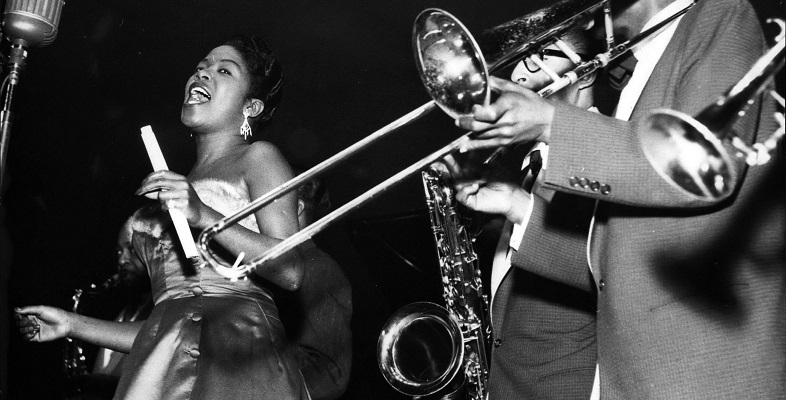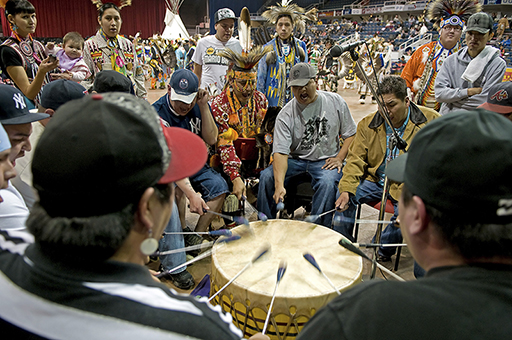4 Powwow song
Specialist terms are also used by the musicians and dancers who perform at powwows – First Nations/Native American gatherings where participants in regalia dance to songs performed by singing groups seated around large round drums (see Figure 4). ‘First Nations’ and ‘Native American’ refer to the Indigenous people of North America. Powwows vary from small community celebrations to immense multi-day gatherings that bring together tens of thousands of people.
Powwows are held across North America, and the dancing and singing at them vary in ways both obvious and subtle, depending in part on the region and the host Indigenous community (see Browner, 2002; 2009). There are generally enough similarities between events, however, that a capable dancer or singer could participate in many different ones each year.
You can hear an example of a powwow song in Audio 4 [Tip: hold Ctrl and click a link to open it in a new tab. (Hide tip)] . It is performed by Red Bull, a Cree drum group led by Edmond Bull, many of whose members are from the community of Little Pine Cree Nation (Saskatchewan, Canada). Red Bull sing in the northern style, whose characteristics include a tense vocal sound and the use of the highest part of the voice.
Powwow songs are usually sung four times through. Each of these iterations is called a push-up. At the beginning of each push-up, a solo singer called the lead sings a section that is also called the lead (Scales, 2012, p. 82; Perea, 2014, p. 32). Next, the rest of the group, called the seconds, joins in, echoing and extending the lead, and this is followed by what is sometimes called the body of the song (Scales, 2012, p. 82). As a push-up is coming to an end, the singers frequently play a series of louder drum strokes called honour beats, check beats, or hard beats (Scales, 2012, p. 83; Perea, 2014, pp. 32–3). Northern-style songs begin in the highest part of the singers’ range and then descend, such that at the end of a push-up the singers are singing much lower than at the start.
Activity 4 Listening to ‘Grass Dance’
The song in Audio 4 is a grass dance song, one of the most common kinds of songs heard at powwows. It follows the form outlined in in Table 4. The table shows the four push-ups, each of which is numbered, as well as the subsections.
Listen to the song three or four times while following along with Table 4 below, until you can perceive the sequence of push-ups without the help of the table.
If you are not previously familiar with this kind of song, you may initially find it difficult to follow the form – in part because the singers sing vocables rather than words, as in many powwow songs. Nevertheless, following the form is relatively straightforward once you know what to listen for, and dancers become so familiar with the form that they are able to dance competently to songs they have never heard before.
| Push-up | Track time | Subsections | Notes | |
|---|---|---|---|---|
| 1 | 00:04 | Lead starts | ||
| 00:11 | Seconds start | |||
| 00:21–01:01 | Body | Honour beats at 00:49–00:54 | ||
| 2 | 01:01 | Lead starts | ||
| 01:08 | Seconds start | |||
| 01:17–01:57 | Body | Honour beats at 01:43–01:50. At 01:55 the drums start playing louder; this continues for the rest of the song | ||
| 3 | 01:56 | Lead starts | This push-up speeds up noticeably | |
| 02:02 | Seconds start | |||
| 02:11–02:48 | Body | |||
| 4 | 02:47 | Lead starts | This push-up also speeds up | |
| 02:53 | Seconds start | |||
| 03:01–03:37 | Body | |||
Comment
You should have been able to hear the structure of the push-ups, and perhaps even begin to predict when a new push-up was about to start. This kind of formal awareness is important for dancers, who keep track of the number of push-ups so that they are prepared for the end of the song. They are expected to stop dancing on the final drumbeat of the final push-up, even in the case of a song they have not heard before.
As the notes in Table 4 suggest, drum groups often vary aspects of the song from push-up to push-up to make the performance dynamic (Scales, 2012, p. 83). Moving from the second push-up into the third and fourth, the group starts drumming more loudly; the third and fourth push-ups also speed up. This is an example of variation: a repetition containing aspects of contrast.
You may have noticed while listening that some parts of the form begin before the previous ones have finished. For example, the body of push-up 2 finishes at 01:57, but the lead of the subsequent push-up begins just before this, at 1:56. The first singer often starts a new push-up just as the others are finishing the old one, thereby binding the sections together. This is an example of elision, in which one part of the form overlaps with another.

